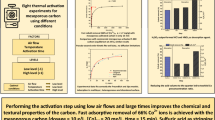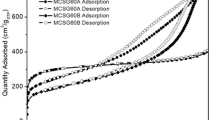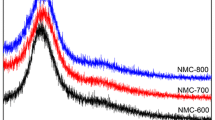Abstract
This work studies gallium preconcentration by means of an adsorption/desorption process using two mesoporous activated carbons synthesized by the replica method as adsorbents. The adsorption results indicate that both carbons can remove 90% of gallium from aqueous solution. Increasing the adsorbent dose favors gallium adsorption and makes the adsorption process strongly pH dependent. However, the most outstanding conclusion is related to the gallium recovery: by using a HF solution as desorbing agent (the same as employed in the adsorbents’ synthesis, in line with circular economy principles), it is possible to regenerate the adsorbent as well as recover 82% of the gallium previously retained. Additionally, the desorption enables sevenfold preconcentration of gallium ions, up to 250 ppm, by reducing the volume of the acidic solution eightfold. This enables further recovery by means of refining processes such as extraction.
Graphical Abstract

















Similar content being viewed by others
Change history
25 February 2021
A Correction to this paper has been published: https://doi.org/10.1007/s40831-021-00349-z
References
Lahiri S, Meyappan RM, Varadharaj A (1996) Gallium recovery-technological alternatives. Bull Electrochem 12:342–345
Ujaczki É, Courtney R, Cusack P et al (2019) Recovery of gallium from bauxite residue using combined oxalic acid leaching with adsorption onto zeolite HY. J Sustain Metall 5:262–274. https://doi.org/10.1007/s40831-019-00226-w
Suryavanshi US, Shukla SR (2009) Adsorption of Ga(III) on oxidized coir. Ind Eng Chem Res 48:870–876. https://doi.org/10.1021/ie801259c
Lu F, Xiao T, Lin J et al (2017) Resources and extraction of gallium: a review. Hydrometallurgy 174:105–115. https://doi.org/10.1016/j.hydromet.2017.10.010
Jaskula BW (2020) Gallium. Mineral Commodity Summaries 2020. United States Geological Survey, Reston, pp 63–64
Zhao Z, Yang Y, Xiao Y, Fan Y (2012) Recovery of gallium from Bayer liquor: a review. Hydrometallurgy 125–126:115–124. https://doi.org/10.1016/j.hydromet.2012.06.002
Jadhav UU, Hocheng H (2012) A review of recovery of metals from industrial waste. J Achiev Mater Manuf Eng 54:159–167
Chegrouche S, Bensmaili A (2002) Removal of Ga(III) from aqueous solution by adsorption on activated bentonite using a factorial design. Water Res 36:2898–2904. https://doi.org/10.1016/S0043-1354(01)00498-5
Kyzas GZ, Deliyanni EA, Matis KA (2016) Activated carbons produced by pyrolysis of waste potato peels: Cobaltions removal by adsorption. Coll Surf A Physicochem Eng Asp 490:74–83. https://doi.org/10.1016/j.colsurfa.2015.11.038
Zanin E, Scapinello J, de Oliveira M et al (2017) Adsorption of heavy metals from wastewater graphic industry using clinoptilolite zeolite as adsorbent. Process Saf Environ Prot 105:194–200. https://doi.org/10.1016/j.psep.2016.11.008
Liang Z, Shi W, Zhao Z et al (2017) The retained templates as “helpers” for the spherical meso-silica in adsorption of heavy metals and impacts of solution chemistry. J Coll Interface Sci 496:382–390. https://doi.org/10.1016/j.jcis.2017.02.024
Burakov AE, Galunin EV, Burakova IV et al (2018) Adsorption of heavy metals on conventional and nanostructured materials for wastewater treatment purposes: a review. Ecotoxicol Environ Saf 148:702–712. https://doi.org/10.1016/j.ecoenv.2017.11.034
Zhao Z, Li X, Chai Y et al (2016) Adsorption performances and mechanisms of amidoxime resin toward gallium(III) and vanadium(V) from Bayer liquor. ACS Sustain Chem Eng 4:53–59. https://doi.org/10.1021/acssuschemeng.5b00307
Zhang L, Zhu Y, Li H et al (2010) Kinetic and thermodynamic studies of adsorption of gallium(III) on nano-TiO2. Rare Met 29:16–20. https://doi.org/10.1007/s12598-010-0003-9
Kadirvelu K, Namasivayam C (2003) Activated carbon from coconut coirpith as metal adsorbent: adsorption of Cd(II) from aqueous solution. Adv Environ Res 7:471–478. https://doi.org/10.1016/S1093-0191(02)00018-7
Demiral H, Güngör C (2016) Adsorption of copper(II) from aqueous solutions on activated carbon prepared from grape bagasse. J Clean Prod 124:103–113. https://doi.org/10.1016/j.jclepro.2016.02.084
Largitte L, Brudey T, Tant T et al (2016) Comparison of the adsorption of lead by activated carbons from three lignocellulosic precursors. Microporous Mesoporous Mater 219:265–275. https://doi.org/10.1016/j.micromeso.2015.07.005
Kuroki A, Hiroto M, Urushihara Y et al (2019) Adsorption mechanism of metal ions on activated carbon. Adsorption 25:1251–1258. https://doi.org/10.1007/s10450-019-00069-7
Barczak M, Michalak-Zwierz K, Gdula K et al (2015) Ordered mesoporous carbons as effective sorbents for removal of heavy metal ions. Microporous Mesoporous Mater 211:162–173. https://doi.org/10.1016/j.micromeso.2015.03.010
Nejad NF, Shams E, Amini MK (2015) Synthesis of magnetic ordered mesoporous carbon (Fe-OMC) adsorbent and its evaluation for fuel desulfurization. J Magn Magn Mater 390:1–7. https://doi.org/10.1016/j.jmmm.2015.04.074
Wu Z, Webley PA, Zhao D (2010) Comprehensive study of pore evolution, mesostructural stability, and simultaneous surface functionalization of ordered mesoporous carbon (FDU-15) by wet oxidation as a promising adsorbent. Langmuir 26:10277–10286. https://doi.org/10.1021/la100455w
Nguyen TH, Lee MS (2019) A review on separation of gallium and indium from leach liquors by solvent extraction and ion exchange. Miner Process Extr Metall Rev 40:278–291. https://doi.org/10.1080/08827508.2018.1538987
Díez E, Gómez JM, Rodríguez A et al (2020) A new mesoporous activated carbon as potential adsorbent for effective indium removal from aqueous solutions. Microporous Mesoporous Mater. https://doi.org/10.1016/j.micromeso.2019.109984
Galán J, Rodríguez A, Gómez JM et al (2013) Reactive dye adsorption onto a novel mesoporous carbon. Chem Eng J 219:62–68. https://doi.org/10.1016/j.cej.2012.12.073
Thommes M, Kaneko K, Neimark AV et al (2015) Physisorption of gases, with special reference to the evaluation of surface area and pore size distribution (IUPAC Technical Report). Pure Appl Chem 87:1051–1069. https://doi.org/10.1515/pac-2014-1117
Sing KSW, Williams RT (2004) Review physisorption hysteresis loops and the characterization of nanoporous materials. Adsorpt Sci Technol 22:773–782. https://doi.org/10.1260/0263617053499032
Fuertes AB, Nevskaia DM (2003) Control of mesoporous structure of carbons synthesised using a mesostructured silica as template. Microporous Mesoporous Mater 62:177–190. https://doi.org/10.1016/S1387-1811(03)00403-7
Lindqvist-Reis P (2000) Structure of solvated metal ions: solution and crystal structure of gallium, indium, scandium, yttrium, lanthanum and calcium ions with water and non-aqueous oxygen donor solvents. Doctoral Thesis, Department of Chemistry, Stockholm
Pretsch C, Seibl S (2009) Structure determination of organic compounds. Springer, Berlin
Pakuła M, Walczyk M, Biniak S, Światkowski A (2007) Electrochemical and FTIR studies of the mutual influence of lead(II) or iron(III) and phenol on their adsorption from aqueous acid solution by modified activated carbons. Chemosphere 69:209–219. https://doi.org/10.1016/j.chemosphere.2007.04.028
Chen C, Gao J, Yan Y (1998) Observation of the type of hydrogen bonds in coal by FTIR. Energy Fuels 12:446–449. https://doi.org/10.1021/ef970100z
Gómez JM, Romero MD, Fernández TM, Díez E (2012) Immobilization of β-glucosidase in fixed bed reactor and evaluation of the enzymatic activity. Bioprocess Biosyst Eng. https://doi.org/10.1007/s00449-012-0728-y
Fanning PE, Vannice MA (1993) A DRIFTS study of the formation of surface groups on carbon by oxidation. Carbon N Y 31:721–730. https://doi.org/10.1016/0008-6223(93)90009-Y
Szymański GS, Karpiński Z, Biniak S, Swiatkowski A (2002) The effect of the gradual thermal decomposition of surface oxygen species on the chemical and catalytic properties of oxidized activated carbon. Carbon N Y 40:2627–2639. https://doi.org/10.1016/S0008-6223(02)00188-4
Gómez JM, Díez E, Bernabé I et al (2018) Effective adsorptive removal of cobalt using mesoporous carbons synthesized by silica gel replica method. Environ Process 5:225–242. https://doi.org/10.1007/s40710-018-0304-9
Nightingale ER (1959) Phenomenological theory of ion solvation. Effective radii of hydrated ions. J Phys Chem 63:1381–1387. https://doi.org/10.1021/j150579a011
Xiang Y, Xu Z, Zhou Y et al (2019) A sustainable ferromanganese biochar adsorbent for effective levofloxacin removal from aqueous medium. Chemosphere 237:124464. https://doi.org/10.1016/j.chemosphere.2019.124464
Ho YS, McKay M (1999) Pseudo-second order model for sorption processes. Process Biochem 34:451–465. https://doi.org/10.1021/acs.oprd.7b00090
Kyzas GZ, Deliyanni EA, Matis KA (2016) Activated carbons produced by pyrolysis of waste potato peels: Cobalt ions removal by adsorption. Coll Surf A Physicochem Eng Asp 490:74–83. https://doi.org/10.1016/j.colsurfa.2015.11.038
Yu F, Wu Y, Li X, Ma J (2012) Kinetic and thermodynamic studies of toluene, ethylbenzene, and m-xylene adsorption from aqueous solutions onto KOH-activated multiwalled carbon nanotubes. J Agric Food Chem 60:12245–12253. https://doi.org/10.1021/jf304104z
Peng W, Li H, Liu Y, Song S (2017) A review on heavy metal ions adsorption from water by graphene oxide and its composites. J Mol Liq 230:496–504. https://doi.org/10.1016/j.molliq.2017.01.064
Bahri Z, Rezai B, Kowsari E (2016) Selective separation of gallium from zinc using flotation: Effect of solution pH value and the separation mechanism. Miner Eng 86:104–113. https://doi.org/10.1016/j.mineng.2015.12.005
Krishnan KA, Anirudhan TS (2008) Kinetic and equilibrium modelling of cobalt(II) adsorption onto bagasse pith based sulphurised activated carbon. Chem Eng J 137:257–264. https://doi.org/10.1016/j.cej.2007.04.029
Giles CH, Smith D, Huitson A (1974) A general treatment and classification of the solute adsorption isotherm. I. Theoretical. J Coll Interface Sci 47:755–765. https://doi.org/10.1016/0021-9797(74)90252-5
Hinz C (2001) Description of sorption data with isotherm equations. Geoderma 99:225–243. https://doi.org/10.1016/S0016-7061(00)00071-9
Gómez JM, Romero MD, Fernández TM, Díez E (2012) Immobilization of β-glucosidase in fixed bed reactor and evaluation of the enzymatic activity. Bioprocess Biosyst Eng 35:1399–1405. https://doi.org/10.1007/s00449-012-0728-y
Essington ME (2003) Surface chemistry and adsorption reactions. Soil and water chemistry: an integrated approach, 1st edn. CRC Press, Boca Raton
Kumar KV, Gadipelli S, Wood B et al (2019) Characterization of the adsorption site energies and heterogeneous surfaces of porous materials. J Mater Chem A 7:10104–10137. https://doi.org/10.1039/c9ta00287a
Holford ICR, Wedderburn RWM, Mattingly GEG (1974) A Langmuir two-surface equation as a model for phosphate adsorption by soils. J Soil Sci 25:242–255. https://doi.org/10.1111/j.1365-2389.1974.tb01121.x
Shuman LM (1975) The effect of soil properties on zinc adsorption by soils. Soil Sci Soc Am J 39:454–458. https://doi.org/10.2136/sssaj1975.03615995003900030025x
Bautista RG (2003) Processing to obtain high-purity gallium. JOM 55:23–26. https://doi.org/10.1007/s11837-003-0155-2
Jelačić BD, Batinić-Haberle I (1986) Method of obtaining gallium from aluminate solution by electrolysis. Mater Sci Technol (United Kingdom) 2:416–419. https://doi.org/10.1179/mst.1986.2.4.416
Paciej RC, Cahen GL, Stoner GE, Gileadi E (1985) Electrolytic recovery of gallium from dilute solutions employing microelectrodes. Electrochem Soc Ext Abstr 85–2:345
Raiguel S, Dehaen W, Binnemans K (2020) Extraction of gallium from simulated Bayer process liquor by Kelex 100 dissolved in ionic liquids. Dalton Trans 49:3532–3544. https://doi.org/10.1039/c9dt04623b
Acknowledgements
This investigation has been financed by the Ministry of Economy and Competitiveness CTQ2014-59011-R (REMEWATER) and CTM2014-53485-REDC (TRAGUANET).
Author information
Authors and Affiliations
Corresponding author
Ethics declarations
Conflict of Interest
On behalf of all authors, the corresponding author states that there are no conflicts of interest.
Additional information
The contributing editor for this article was Yongxiang Yang.
Publisher’s Note
Springer Nature remains neutral with regard to jurisdictional claims in published maps and institutional affiliations.
The original version of this article was revised: As a result of an error during the publication process, the graphic for Fig. 1 was mistakenly replaced with the graphic for Fig. 3 in the PDF version of this article as originally published. The PDF version of the article has been corrected.
Rights and permissions
About this article
Cite this article
Díez, E., Gómez, J.M., Rodríguez, A. et al. Recovery of Gallium from Aqueous Solution through Preconcentration by Adsorption/Desorption on Disordered Mesoporous Carbon. J. Sustain. Metall. 7, 227–242 (2021). https://doi.org/10.1007/s40831-021-00336-4
Received:
Accepted:
Published:
Issue Date:
DOI: https://doi.org/10.1007/s40831-021-00336-4




